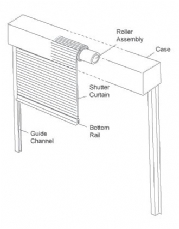 Add My Company
Add My Company
Sign In

Domestic Roller Shutters
The increasing need for security in the home has led to an expansion in the market and the development of shutters that are both secure and attractive on a residential property. They generally have a smaller width profile than shop front or industrial shutters. As well as being a deterrent to entry, they also insulate against nocturnal radiation and thus have a significant benefit in heat retention in winter. Special lath sections are available that are foam filled to improve insulation.
Types and operation
Built-on
Describes the type where the roller shutter box is fixed to the exterior of the building facade.
Built-in
Where the roller shutter box is built into the lintel above the window.
Integrated roller shutter
A roller shutter and window combined as a single unit.
Roller shutter with tilting laths
A roller shutter with laths that tilt, similar to an external venetian blind.
Manual
With gear drive from the shutter roller traced through the building facade to a universal joint on the room side that is operated by a cranked winding handle.
Manual tape
A tape drive around a flange on the roller is traced through the building facade with pulley guides to an inertia reel on the room side.
Electric
With a tubular motor fitted within the roller. Automatic operation is available.
Components
Lath
Aluminium or PVC extrusion, single or multi wall.
Roller (or roller tube)
Aluminium tube supported at either end by an end cheek.
Shutter box
Aluminium extrusions designed to protect the roller assembly
Guide rail
Aluminium to retain the shutter curtain. Rubbing strips to reduce rattle and draught strips are available.
Bottom lath
Aluminium or PVC to match the lath. Rubber tube to reduce draught is available.
For more information on Domestic Roller Shutters explained talk to British Blind & Shutter Association
Enquire Now
List your company on FindTheNeedle.
